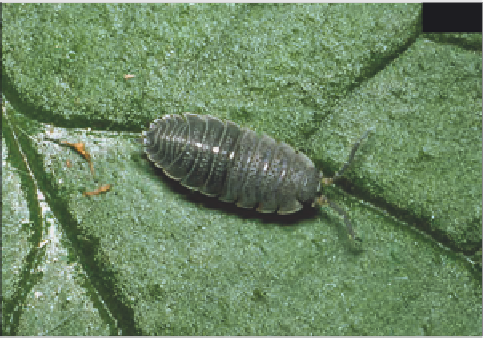Biology Reference
In-Depth Information
Family
ONISCIDAE
Family
PORCELLIONIDAE
Woodlice with flagellar segment of the antennae
divided into three sections.
Woodlice with flagellar segment of the antennae
divided into two sections; body distinctly flattened.
Oniscus asellus
Linnaeus (
1141
)
Grey garden woodlouse
Widespread and common, often sheltering in
considerable numbers beneath bricks, stones and pieces
of rotting wood. Damage is often caused in greenhouses
to the young, tender growth of ornamentals, especially
carnation (
Dianthus caryophyllus
) and sweet pea
(
Lathyrus odoratus
); aerial roots of orchids are also
attacked. Adults are 16 mm long, shiny grey, with
irregular pale patches; the body is relatively broad.
Porcellio dilatatus
Brand
This species occurs in abundance beneath seed boxes
and flower pots in cold-frames and in unheated
greenhouses, often attacking the roots of cultivated
plants. Adults are 15 mm long, and greyish brown with
distinctive lateral stripes; the body is noticeably
roughened, and the telson, which reaches just beyond
the endopodites, usually has a rounded tip.
Porcellio laevis
Latreille
A locally common species in manure heaps and, if
introduced into greenhouses, damaging to the roots of
ornamental plants, including various ferns. Adults are
18 mm long, brown, smooth and glossy; the telson has
a pointed tip and the uropods are very long.
Porcellio scaber
Latreille (
1142
)
Garden woodlouse
This widespread and common species sometimes
damages plants in cold-frames and seed boxes, but is
not usually a problem in greenhouses. Adults are 17 mm
long, dark slate-grey, with a roughened body and a
pointed telson; the basal antennal segment is usually
orange. Juveniles are often yellow or orange.
1141
1142
1141
Grey garden woodlouse (
Oniscus asellus
).
1142
Garden woodlouse (
Porcellio scaber
).


Search WWH ::

Custom Search